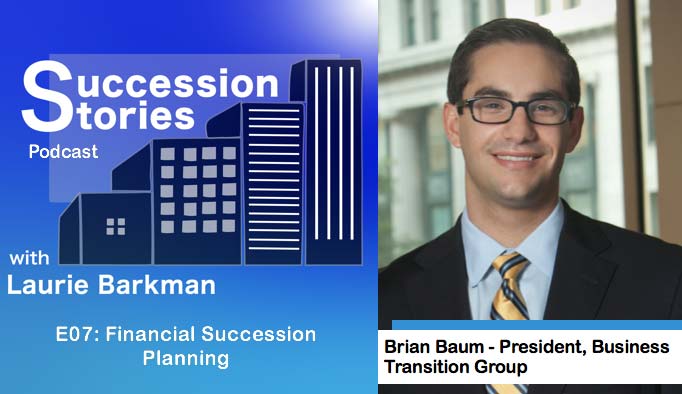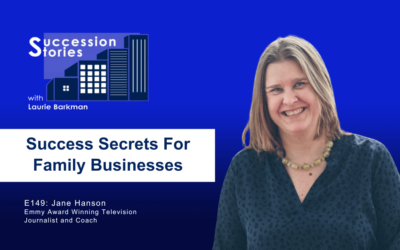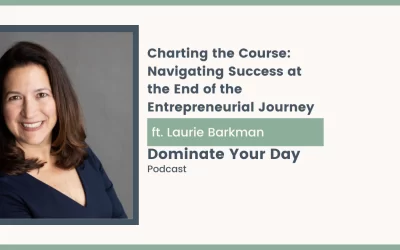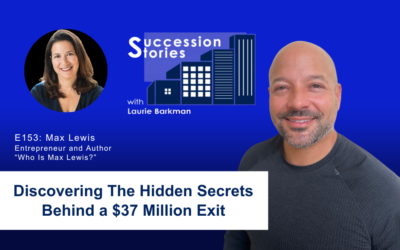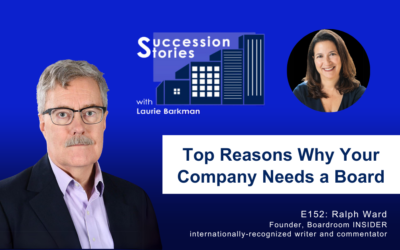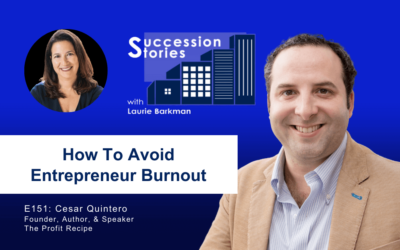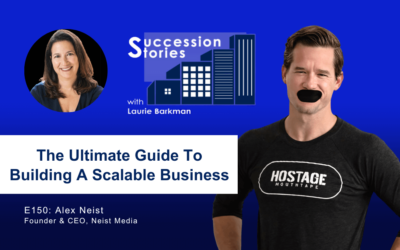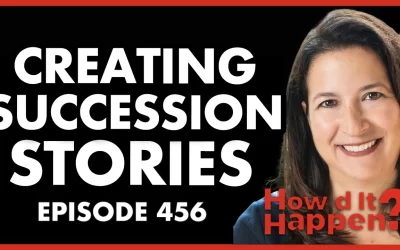Listen to the full episode using the player below:
On this episode, listen in as Laurie Barkman speaks with Brian Baum, President of The Business Transition Group and chair of the Pittsburgh Exit Planning chapter. Brian works with multi-generational businesses to de-mystify the transition and exit planning process.
If you’ve wondered how the financial transition planning process might work for your business, or how to get started, this episode is for you.
– phases of exit planning: Discover, Prepare and Decide
– fundamentals of business valuations
– de-risking the business
– role of external advisors
Overall, it was a great conversation about taking a proactive approach for your future.
Thanks for tuning in!
Show Links
- Brian Baum LinkedIn
- The Business Transition Group
- Pittsburgh Exit Planning Chapter
- Exit Planning Institute
- Biz Equity
- Harvard M&A Advisor report
Recorded on SquadCast.fm
Follow Succession Stories Podcast on LinkedIn
Full Transcript
Laurie Barkman:
Welcome to Succession Stories, insights for next generation entrepreneurs. I’m Laurie Barkman. I’ve spent my career bringing an entrepreneurial approach to mature companies struggling with change as an outside executive of a third generation, 120 year old company, I was part of a long-term succession plan. Now I work with entrepreneurs, privately held companies and family businesses to develop innovations that create enterprise value and transition plans to achieve their long-term goals. On this podcast, listen in as I talk with entrepreneurs who are driving innovation and culture change. I speak with owners who successfully transitioned their company and others who experienced disappointment along the way. Guests also include experts in multi-generational businesses and entrepreneurship. If you are a next generation entrepreneur looking for inspiration to grow and thrive, or an owner who can’t figure out the best way to transition their closely held company, this podcast is for you.
Laurie Barkman:
On this episode I’m joined by Brian Baum, President of The Business Transition Group and he also runs the Pittsburgh chapter of the Exit Planning Institute. Brian works with multi-generational businesses for transition and exit planning, and he provided a helpful overview of the process. In today’s environment, many businesses are busy navigating the now, and as always, it starts with owner readiness. Brian talked about how the transition planning process works and ways for owners to get started. He hit on three phases of exit planning: Discover, Prepare and Decide, fundamentals of business valuations, ways to de-risk the business, and the role of external advisors. Overall, it was a great conversation about taking a proactive approach for your future. Thanks for tuning in and enjoy the episode.
Laurie Barkman:
Brian, thanks so much for joining me today on Succession Stories. It’s really great to have you here. There’s a lot of companies feeling pretty upended right now and uncertain about their future. So I’m excited to talk to you today about transitions. One of the quotes I saw recently from McKinsey said, “navigate the now, plan for the recovery, shape the future.” And so as we talk today about transitions and your firm, The Business Transition Group, I have a feeling that you can really relate to that saying, so I thought it’d be a great place to start. Tell me a bit about The Business Transition group and your work with privately held companies.
Brian Baum:
Absolutely. And thank you for having me today, Laurie. So The Business Transition group is what I would call eight years in the making. You know, it started back when I initially joined my dad’s predominantly wealth management group and we were kind of sitting around our kitchen table trying to figure out how do you get a 22 year old kid into a very mature, stable and challenging business. And he looked at it as almost a redo, if he had an opportunity to go back and start fresh, what would he do? And we came up with focusing exclusively on privately held businesses that the bulk of their assets is illiquid. And I kind of remember, I laughed at him. I said, that sounds awesome in theory dad, but I’m 22 years old, what CEO is gonna talk to a 22 year old kid?
Brian Baum:
So it really started with a book series that we started called Profiles of Success. And throughout all these interviews that I had with thousands of entrepreneurs, family business leaders around the country, but predominantly here in Western Pennsylvania, they all had a very similar issue. In one way or another it boiled down to not knowing how they were going to get out of the business. They knew the concepts, they knew the ideas, but whenever you actually go in and you start working through that process, it’s just fraught with landmines everywhere and discouragement a lot of times. So that really set us down this path of working with privately held companies, family businesses, and the like.
Laurie Barkman:
Discouragement, landmines, issues. That sounds like a great place to start. I’m curious about the types of multi-generational companies that you work with. Do they fall into a certain category, like an industry or the size of the business, or geography? You mentioned Western Pennsylvania. Do you focus in that geography predominantly?
Brian Baum:
Initially it did start as Western Pennsylvania. Now we have clients all over the country as far as California, New York, Florida. They’re all over the map. They do have roots that are tied to Pittsburgh, but they don’t necessarily live here or operate their companies here any longer. In terms of size ranges, a lot of the companies that we work with tend to be what I would call the middle market space. Now that’s defined differently depending on who you talk to and which direction the wind is blowing on a particular day. But I define it as a $25 million enterprise value to around a $300 million enterprise value. So that brings in a lot of different companies’ ranges from revenue to EBITDA because each industry is going to be valued slightly differently.
Laurie Barkman:
I love the idea of the book tour that you did, and how you got out there as a 22 year old and said, hey, I want to understand this landscape a bit better. Did you find that those companies were pretty receptive to talk to you?
Brian Baum:
Surprisingly, yes. I had a very high success ratio of people that would say, yes, I’ll take a meeting or yes, I’ll take a call. I think it was somewhere in the eighties or the nineties actually. I would have to be pretty persistent and called them a bunch of times because these people are very busy. But ultimately once I did get someone on the phone, there was a higher probability of them saying, yes, I’ll indulge you all, I’ll do this interview, I’ll talk to you, then them saying no.
Laurie Barkman:
And what a great way to learn by getting out there and talking to potential clients. So tell me a little bit more about the process that you use, and your firm uses, to work with business owners for transition and exit planning. I think in your information that you shared with me, one of the key processes is called Value Acceleration, which sounds pretty incredible. Those two words put together, they have a lot of power– value acceleration. What are the key phases of value acceleration? What does that mean?
Brian Baum:
Sure. So before I get into that, I’d like to read one thing because I think it’s probably the most powerful phrase that that we have, and it really encompasses what exit planning is and dives into our process a little bit.
Exit planning combines the plan, concept, effort and process into a clear, simple strategy to build a business that is transferable through strong human, structural, customer, and social capital. The future of you, your family and your business are addressed by exit planning through creating value today.
So when we talk about value acceleration, we’re talking about today, we’re not talking about starting something in three years, in two years, in five years. We’re talking about today because we believe that each day we are making decisions. Some are small, some are large, some are going to have a week long feedback loop, some are going to have years.
Brian Baum:
And we don’t necessarily know what that decision is going to look like until years down the road when we either say, wow, that was a great decision, really happy that we made it. Or wow, that was a terrible decision, why didn’t we foresee this at the time?
Our process has three core phases to it, and they are Discover, Prepare and Decide. In the Discover phase, all we’re doing is we’re trying to get a baseline understanding of two main things. The first is we want to get a baseline of where the value gaps are. So where’s the value of the business. What’s the profit gap look like? What’s the wealth gap look like for the family? And what does the value gap look like? We’re also using this time to assess three other areas, which are the personal, the financial, and the business dynamics, and how those three intersect.
Brian Baum:
And we use something called “Common Sense Scoring” and instead of it being one through five, it’s one through six because we don’t want anyone to be able to answer that they are average in any category. So either three are slightly below average or four are slightly above average. And by doing this, it forces a business owner to think critically about their company, their family, and their financial situation to help be truthful to us so that we can advise them appropriately of where do we need to focus. Because all of those pieces together drive us into our first prioritized action plan. And this is everything under the sun that we, their management team, their other advisors, have basically decided that if we really do want to build something that’s transferrable, and focus on value today, here’s where we’re going to need to spend some time. And that’s just the Discover phase. When we move into the Prepare phases, this is more setting up the foundation for what the next chapter is going to look like.
Brian Baum:
We do this in two ways so we’re running a parallel track working on de-risking the business, focusing on foundational items. These are things as small as: do we have the proper insurances in place, to as large as: is our shareholder agreement structured appropriately? And then at the same time we’re working on the family level because the one piece, and I have to push back on clients about this, is business is personal, and what your family wants, and what you want as an individual, matters more than you realize to the business. If you personally aren’t engaged in growing this business, it’s going to show up in all the strategies that we try to implement within the company. So we need to start getting them to envision what life is going to be like, what that third act could potentially be, whenever they’re no longer in the day to day running of this organization.
Brian Baum:
So that’s an envisioning strategy, or an envisioning workshop, that we would do with them to be able to get them to see that they’re not just going to die after they sell this company, or after they transitioned to their son or their management team, but there is a next act. We just want to be thoughtful about what we’re doing. So that’s why we run a Family Track and to prepare them both from a structural and kind of an emotional health standpoint as well. And the Decide phase ties all of it back together because every 90 days, we start asking a simple question: do you want to continue to grow this business or is it time to exit? And we do that so regularly because we want them to understand that that is a conscious choice that they are making every single quarter. You’re either choosing to continue to grow your business or you can choose to exit your business and enact that transition strategy. And that allows us to just test the waters, see where their head is at, where are they mentally, and figure out are we focusing on value creating opportunities and priorities the next quarter, or should we enact our sale option, whether it’s internal or external.
Laurie Barkman:
You did a great job of explaining a pretty complicated process in a pretty clear way. Just want to pause and have you unpack a couple of things here. I think in the first phase, you mentioned for Discovery, try and identify the value gaps and the three aspects for the owner, the personal, financial and the business. We’ll just spend another minute on that because I think you mentioned something that was really important, which is you don’t want the owners in the future if they have an exit to be unhappy, essentially right, to regret that sale. And so it does involve the owners, but then it also involves others, right? Their family members, other stakeholders in the business. So can you spend just a little bit more time on that? On the personal, financial and business, what types of questions are you asking at that phase? Is this an assessment of readiness essentially?
Brian Baum:
Yes. That is 100 percent correct. We are trying to figure out two main things. We’re trying to figure out how attractive is the business to a theoretical buyer, and how ready is the owner to transact in whatever form that might mean. And we use those scores as a way to find the intangibles. A lot of business valuation can be summed up as you know, here’s our EBITDA earnings before interest, taxes, depreciation, amortization – for those that don’t know that acronym- times some multiple. And that multiple largely is made up of kind of four intangible capitals that I talked about briefly- the human, your people, the structural, your processes and systems, the social, your culture that you’ve built and your customer capital. And that drives that multiple a lot of times. So we’re trying to figure out, well how strong are you in those categories from a business standpoint that helps lead to the attractiveness piece.
Brian Baum:
But we also know that there’s a family side of this too. And that can also blow up an opportunity if the family isn’t on board or someone gets cold feet or anything like that. So that’s why we bring in the owner readiness aspect of it as well because the more ready they will be, the more likely they will be to be comfortable moving through the process, and actually excited to move through the process. And one of my favorite stories is, I was talking with a client. A lot of times this is a chore for them to try to figure out what they want to do afterwards. And he goes, Brian, you don’t have to worry about me. I know exactly what I want to do. I say, okay, lay it on me. What do you want to do? And he goes, I’m going to move to San Diego and I’m going to open up a motorcycle shop, and he goes, I’m just going to sell motorcycles for the rest of my days. This guy is not in the motorcycle industry. He just really likes motorcycles.
Laurie Barkman:
That’s great. He had a very clear vision all the way down to San Diego. He had spent a lot of time thinking about that. That’s awesome. That makes me wonder for the people that you start these readiness conversations with, how does that even happen? Is this, they were calling you saying, I think I’m ready, or is this a conversation that is sort of like ten conversations in the making? I can imagine that owner readiness is not overnight, especially for, let’s call it the generation of entrepreneurs where their identity is so tied in to this business. Tell me a little bit about that. What does that entail? You know, is it again, is it like ten conversations to get to that point?
Brian Baum:
It’s ten conversations to get to that point. Absolutely. And sometimes many, many more. You know what I do and what our group does is not mainstream. It’s not as simple as going to an estate planning lawyer and saying, I need a will. I need the trust, I need powers of attorney. It’s hard to see. It’s hard to touch. We can describe it very well. We are very, very good at it. But to a business owner that is looking to figure out where does he spend his money on a monthly, quarterly, yearly basis, larger, more urgent items pop up and they believe that is where they should focus their time. So it does take us a lot of time to truly understand the business, understand the owner, understand the dynamics at play before they will just raise their hand and say, all right, I’ll take a shot at this because I think I’m at that point now.
Brian Baum:
They all reached that point. Sometimes they reached that point too late, which occurred with a potential client. Last year with us where he just, he wouldn’t listen to me until about maybe a month before his deal closed. And then I unfortunately had to blow up everything that him and his team thought was correct. And it was unfortunate because he missed out on close to $17 million in either tax benefits or value to his company.
And that’s obviously an extreme example, but those show up more often than people realize. And I think my goal is I would like to get the, “well, that’s not going to happen to me off the table” by saying, you’re right, if you worked with us, it won’t happen to you. But if you don’t, I can’t guarantee that it won’t.
Laurie Barkman:
For the clients that you work with, do you find that their interest in talking about transition is mostly about selling the business, or do you also have conversations about other options such as ESOPs and family member transitions?
Brian Baum:
So our goal is not to choose the transition path for them. Our goal is to educate them on all of the options. A lot of times they don’t know of all the options. There’s probably ten different options that I can think of and they could work together. You can build hybrids of these or you can go down one singular path. But a lot of people just don’t realize that there are as many options available to them as there are. And that just comes down to education. So our first goal is let’s educate them on the process as well as the options. From there we can pretty quickly close a couple of those doors due to other factors that either aren’t present currently, or we tell them would take longer to open that door back up. A lot of times that does fall into the family intergenerational transfer. That one I find most people want to do. However, for a myriad of factors, it’s not going to work. Both for the incoming generation as well as the outgoing generation. And it’s unfortunate because there’s no reason that it can’t work, but usually it is due to lack of preparation and lack of running both the company and the family in a manner that allows it to happen. It’s much more technical than people realize. The easiest frankly is just selling to a third party.
Laurie Barkman:
So it really does depend on a lot of different factors for that owner, for the company, for the family. On this podcast, Succession Stories, we have also spent time talking with family business professionals and they work with family businesses on their strategy planning, and it’s a journey. That’s what we’ve talked about. So for some companies, you know, as you said, it just might not work out potentially. There’s no one to transition to. They’re not interested or it’s just for whatever reason it’s just not right. And so these other options that you said, there’s about then or so. Besides selling the company, we’ll talk about more about that in a second, but besides the sale of a company, what are some of the other options that you tend to see as effective for your clients that it fits their needs?
Brian Baum:
Absolutely. So one of my favorite ones is one that is not actually talked about because it combines about four of the strategies into one. And that would be what I would call a hybrid transition strategy. And it loosely goes something like this. You’re trying to grow your business and to do that you need capital. You also need to get the buy-in from your employees. So the first thing you might do is you might go to your leadership team and you might set up some KPIs, some milestones that they need to hit. Then you will attach a cash bonus but also potentially equity into that compensation. So maybe it’s call it 10% and whenever you hit those milestones, they have to purchase that equity from you. So that gives the business owner some time to say, all right, I’m going to sell 10% of my equity fair valuation.
Brian Baum:
And over time, those people that are buying it are going to pay me that portion. So that happens. Maybe then two or three years later we say, you know what? We want to do an employee stock ownership plan now. So we’re going to sell, call it the remaining 39% of our company to an ESOP. Now we’re 49% owned by an ESOP 51% owned by the family. So now he’s been able to take more cash off the table while also once again being able to grow, fund, get more people engaged. Then we say, okay, it’s time to sell a majority stake because we now need more firepower. We need more professional help with all of this. So we sell control. And now we sell another, call it 30%, so now we’re up to 79% of our equity. So we’re holding on to 21% and now we are own majority by an ESOP as well as a private equity firm.
Brian Baum:
And now we’re trying to grow the company even further to the point where then our next hit would be when we sell the company finally and we say we’re out. Now, that can be a five year process. That could be a ten year process. That can be something you do over 20 years potentially.
But what you’ve done is you’ve been able to monetize along the way so that frankly, whenever you’re in situations like we are right now, your company is well capitalized. You have people that are very, very loyal to the cause and you as a family are secure because you’re not living paycheck to paycheck from that bank account, which is your company. So that’s a strategy that I like a lot because it doesn’t tell an owner that they have to sell everything all at once. It says slowly but surely, let’s find a path that works for you. We call it a hybrid exit strategy because you’re using a lot of different pieces to build the ultimate transition.
Laurie Barkman:
That’s an excellent example. Thanks for sharing that because I think it does paint a picture of what is possible and that sort of underscores what you’ve been saying, which is really the exploration and seeing – exploring with owners what makes sense for them. An ESOP is a topic we’re going to dig in deeply on another episode of show so that tees it up nicely, so thanks for that. I want to circle back to the topic of selling. Selling, whether it’s a 100 percent or selling a portion. One of the things I read in your company materials was that the majority of small private firms are sold as asset sales and the majority of middle market transactions involve the sale of equity. I was hoping for our audience you could define some of those business valuation terms and which business value conclusion is really the most important to pay attention to. If owners are getting value assessments back from a firm like yours, how do they interpret those terms? What do they mean?
Brian Baum:
Of course. First I have to preface this with if you are getting a valuation, there are about ten different ways to value a company at the exact same time. And they vary depending on what the goal is. So in our case when we are using an evaluation tool, which we use Biz Equity, we’re trying to figure out what the fair market value of the company is if we were to sell a controlling stake. We break that out into four main categories: the asset value, the equity value, the enterprise value, and the liquidation value. Now the asset sale value, that is the value of your assets. Now these are tangible assets that you can touch, feel, see, machinery, computers, things like that. But it is also comprised of goodwill, customer lists, and those also go into the asset sale category.
Brian Baum:
It does not include any liabilities in that calculation. It’s just the assets, the equity value includes cash that you have on your balance sheet. So that brings that into the equation. And that is really the number that we look at the most times what that equity value would be as a fair market, because that includes the assets plus any cash minus any debt that would come off of the final sale price. So that’s the one that we like to look at the most. And then there is the enterprise value and this takes into account the value of the entire capital structure, the equity holders and the debt holders to figure out what the value of that company would be. And then finally, the least fun of all of the valuations is the liquidation value. But we show this because we have to make sure that our clients understand that even the best run companies can be growing broke and liquidation can become an option, unfortunately. And that’s insolvency, selling assets at rock bottom prices, trying to get something for them.
Laurie Bakman:
And I’m sure liquidation happens. It’s probably a smaller percentage a versus these other ones, hopefully.
Brian Baum:
Hopefully. And we try to make sure of that. That’s one of the reasons why we exist.
Laurie Barkman:
Exactly. And that’s sort of the point to make sure. This process you mentioned can take years, right? What’s an average length of time from when you’d say “the beginning” –from that conversation with the owner about readiness, and the assessment process that you mentioned in the beginning– to when a decision is actually made…is that months, years?
Brian Baum:
It’s usually measured in years. It’s as short as two years. It can be as long as ten.
Laurie Barkman:
So it’s a journey. It’s a marathon, not a sprint, as they say, right?
Brian Baum:
It is a marathon, not a sprint. Contrary to popular belief, every owner has plenty of time in the day to focus a little bit on this. This is not something that needs to consume as much time as they think it does. There might be points in a month where you’re spending more time on it than not, but it’s not going to ruin your business by focusing on this. In fact, this is going to help your business by doing that.
Laurie Barkman:
Let’s talk about that no in your experience how owners have been able to spend time on this. Who is involved? Who are the people that they should surround themselves with? Certainly the people within their company, their key leadership team. And you mentioned them earlier as being pretty critical. Who in addition to the leadership team are the key advisors in this type of process?
Brian Baum
Yeah, absolutely. The core group of what I would call external advisors would consist of a planning oriented accounting firm. So one that is well suited to be able to help with tax mitigation strategies whenever we sell the company to whomever as well as entity structures and just generally being able to help us understand what are the tax implications of the different options we’re looking at. So that’s what we’re looking for from a tax perspective. From a legal perspective, we’re going to want someone who is very confident in themselves whenever it comes to mergers and acquisitions. Because ultimately it does become a negotiation and the lawyers are usually part of that front line team to be able to negotiate and structure things for the clients. We also always suggest, and if they work with us, we require that if they’re going to sell their company to a third party, there has to be an investment banker involved.
Brian Baum:
Studies show, and this was an academic study that I read years ago, that companies that hired an investment banker, paid them their fee received on average, I think it was 15% to 20% higher value for the company than those that went direct or tried to run a process on their own. We highly, highly recommend, and require if they work with us, that they use an investment banker. And then a group like ours, you have to have a quarterback to this. You have to have someone that is focusing on values. So we look at ourselves as a Chief Value Officer within the whole client’s companies for a short period of time. And we also play the role of a financial advisor for them because we can see and model out what the after tax cashflow implications of different sale options are going to look like for the family themselves. And that’s something that happens a little too late. People will sell their companies and then they’ll go and say, do I have enough money? I’ve $10 million. And they said, well, you know, you’ve been spending $1 million a year for the past 50 years. So you took a pay cut with this deal and no owner wants to know that they took a pay cut whenever they sell their company.
Laurie Barkman:
No, definitely not. Having the right people supporting the process is pretty critical from all those different standpoints. There’s so many specialties and so many nuances. It’s a pretty complicated process. So the next question for you is regarding owners and how they see their future of their business. As we mentioned, at the start of the show, it’s kind of a trying time right now for a lot of companies with the COVID-19 pandemic and a lot of companies are forced to think about things differently, and maybe sooner than they expected to. Certainly change is constant, but this is a rapid fire sense of change for many. And I was wondering about your clients and what you’re seeing. Are your clients putting this strategic work on the back burner for now or are you finding that they’re still very much looking ahead?
Brian Baum:
So I think, if you had asked me that three weeks ago, it would be, we’re putting it on pause at the moment. Now we are starting to see that some are picking their heads up and realizing that they’re going to be okay. One of the things that we did with all of our clients, over the past few years is we tried to reset what their bank accounts zero looked like. All I mean by that is their new zero was two months of operating cash flows in the bank. So if it went below that they were below zero. We did that because one of the foundational pieces of de-risking is we have to have enough cash to weather any storm that might come. Now we did not predict that this was going to be that storm.
Brian Baum:
That we were going to completely shut down a lot of our operations. But nonetheless it was unforeseeable and that’s why we wanted them to have the cash so they have the cash there. They’re able to weather this. So now that we’re starting to see some movement with the disease and largely it’s going to be a medical solution, it’s not going to be, a business timing one. But whenever the medical community comes out and says, okay, we’re able to go back to work, we’re able to resume somewhat of normal activities, I think you’re going to see more activity pickup. But right now we’re having conversations with our clients that go something like this. We’re going to focus on the short term and we’re going to secure the company right now. We’re going to understand the new Cares Act and we’re going to be able to help advise you and walk you through some of those pieces.
Brian Baum:
At the same time, I don’t want you to lose sight that there is going to be a medium term. There’s going to be a future of this and a company like yours is, a lot of our companies are pretty well positioned right now to capture some unbelievable opportunities that I know will be presenting themselves in the coming months to be able to take advantage of those. Now, those could be in terms of new products that they can be able to sell into the markets. They could also be in the form of buying other businesses that didn’t fare as well, but maybe they have great customer lists. Maybe they have assets that they want. Maybe there’s something there that will help that company grow and they can absorb them into their enterprise. So we’re looking at this and saying two things. One, private equity has a historic amount of cash on their balance sheets right now.
Brian Baum:
I think last I saw was about $2 trillion and they have been waiting for an opportunity like this. At the same time, we have a lot of baby boomers who were starting to look at processes to sell their companies right before all of this happened. But have very quickly hit the pause button.
I think you’re going to see a lot of them who would have sold to maybe strategic buyers look at private equity as an opportunity to say, hey, let’s get some cash in the bank. Let’s go out and buy some assets and let’s grow this together so that I can take some chips off the table right now and I can get a second bite at the apple into the future. I think that’s going to be a story that plays itself on repeat over the next few months and that’s what we’re talking with our clients about right now. We’re talking about understanding where they see themselves in that medium and long-term future and what are the things you have to be preparing for today to be able to capture that into the future.
Laurie Barkman:
That sounds like a really important conversation to be having with them. And in terms of advising, it sounds like pretty sound advice and I think back to where we started, which navigating the now, right? Being able to have that cash in the bank and being in a good place for that. So it’s good to hear that you think most of your clients are secure right now. That’s important. Then starting to really plan ahead and shape that opportunity to be ready for those opportunities when they come knocking. There was another podcast interview that I did with Tony Uphoff, the CEO of Thomas. Many of their clients are manufacturers, privately held family businesses in the manufacturing space. One of the things that he talked about was the cash rich PE firms that do come in knocking on the doors of these owners of manufacturing firms, and a lot of times the owners are not ready for those conversations.
Laurie Barkman:
And so in this environment, as you described if the PE firms are have been waiting for some of these opportunities. The time may be right for these owners to take a look at that and certainly in Western Pennsylvania, I think there’s many manufacturing firms that may be fitting into those conversations. I’d like to also ask you, Brian, along the lines of what if a closely held company owner has not yet started really having conversations? Maybe they’ve been thinking about it, and they’ve been starting to maybe, wonder what things they might consider, what are the things that they should do as a next step? How do they find a firm like yours and who should they be talking to?
Brian Baum:
So typically what we will see is the first person they’ll talk to is their spouse. The second person they will talk to is their accountant. And then after that it gets a little blurry in terms of who they will actually go to. What I would say is that there are two main things they have to do. The first is you absolutely need to get an understanding of your value today. That is critical. There’s no sense in figuring out how you’re going to grow if you don’t know what you’re valued at today. And I’ve had conversations with people that have very high revenues, $30 million in revenue. Whenever you showed them the valuation, you showed them how much they have to pay after the potential buyer takes out all the debt- because buyer’s not taking on your debt – they don’t have as much as they necessarily thought.
Brian Baum:
So you need to get that understanding of what the value is going to be of your company and what can actually come to you and your family. That’s critical. The second is you need to start thinking in terms of a buyer. If a buyer were to walk through your facility, what are they going to really like? What are they going to say? You got to fix that before I even think about buying this or think about coming in as a partner. This goes down to is your facility clean? Does it look presentable whenever someone walks in? Is it professionally run? Whenever someone comes in does someone greet them? The little things, those little small details, they weigh heavily on potential buyers. So you have to start thinking a little bit more like a buyer and not like the person who ran include this company and try to pull yourself away from that. And that’s I think why our group, and groups like ours, are able to help because we can see things that an owner might be blind to.
Laurie Barkman:
Thinking like a buyer, that’s a pretty solid piece of advice there. Put yourself in their shoes and then walk into your environment. You’ve probably seen a few situations where it was too late. You mentioned earlier one of your client’s situations where it was too late and they lost out on value. It sounds like the transaction still went through, but I know that there’s some other business exits that are not voluntary, sometimes upwards of 50%. I think the Exit Planning Institute has that statistic out there. Can you talk about some of the circumstances that cause some of those unexpected things, and ways to address those proactively?
Brian Baum:
Absolutely. They typically fall into the five D’s. I might miss a D, but the D for the predominant ones are divorce, death, disability, disagreement, and I think disengagement is the fifth. Obviously the largest one is death, divorce and disability. Those three probably comprised of I think 80% of the involuntary sales that we see. Death of an owner, death of a partner, divorce of a partner, disability. They all have the ability to majorly rock the business to its core. And you can plan for all of them and there are strategies to be able to make all of them essentially null and void. But the key word is you have to plan for it. And all too often there isn’t enough forethought because again, we all kind of have a hero complex and saying, well, that will never happen to me.
Brian Baum:
It does happen, and it can happen to you. There’s no reason that it can’t. Please, please, please stop thinking it can’t happen to you. The other one’s disagreement and disengagement. Those are typically whenever there’s partners involved, and the disagreement one pops up a good amount too. If you can’t come up with an agreement or a way forward with the business, a lot of times they’ll just dissolve their ownership. I’ve seen that happen a lot as well. But those are probably the bigger ones that cause an involuntary sale of the business in one way shape or form.
Laurie Barkman:
So what are the proactive things that they can do? So one is probably insurance related regarding death. But also succession planning, and having that next person groomed. What’s the next generation development? On another show, we did talk about that from a family perspective. But there’s also the management and you can hire from the outside in anticipation of the next generation being ready even if it’s going to take another ten years. That certainly would be one option. On disability, divorce, I mean some of those things you just hate to think about. But with 80% of them being divorced, death or disability, it certainly sounds like the prudent thing to do to have contingency plans in place so that there are no surprises that can’t be handled.
Brian Baum:
Correct. I completely agree. And some of the things you can do, insurance is absolutely one. Proper entity structures for the divorce piece is also one. Now, you can’t really dive into the family side too much, but if you happen to have a prenuptial agreement and you’re able to have that be a component of the succession or the exit. Meaning that basically that strips out the business, and says that if we get divorced, you don’t get any of the business, I don’t have to pay you a portion of the value. That helps because a lot of times what occurs is we have to value that business because the husband and wife own that 50/50, if it’s just the husband. That’s just how the laws in our country work for most states.
Brian Baum:
And that’s one that is very challenging to work through, which is why it’s one of the hardest to figure out because usually it’s too late to plan for it. Once you need to plan for it. Disagreements, they’re a little easier. But usually you just need to have two level headed owners to be able to work through any challenges or disagreements that arise. And you also need to have a mechanism to not allow them to fester. You have to have meetings and issues that you’re able to work through together as a team to be able to work through those disagreements as they come, because otherwise they can spiral way out of control.
Laurie Barkman:
Understandable. Then being in control is where it’s at, and no one wants to be out of control. So last question for you, Brian. I like to ask all of my guests, what is your favorite saying or mantra regarding entrepreneurship?
Brian Baum:
Well, my favorite one, it’s actually from Mark Twain. He says, ain’t in it. But you know, really the quote is, and it’s from Mark Twain,
“It’s not what you don’t know that gets you into trouble. It’s what you know for sure that just isn’t so.”
So, that’s my favorite quote. And I think that it applies to every business. I think it applies to every person because we all have a belief system and our belief system is based off of our past experiences. Now, some of those past experiences have led us down a true path, meaning that it’s factual. While others have skewed what is reality. And a lot of times whenever we’re having conversations with highly, highly accomplished, highly intelligent owners, we have to try to level set their thinking in this. And really we need to come to the table as equals and have them understand that, look, I’m not trying to tell you I know everything about your business because that’s false. I don’t.
Brian Baum:
But we also expect don’t come to us and think that you know everything about our business or the strategies that are possible because you don’t. So we liked that quote because it really allows us to talk openly with people and make sure that we’re educating them in the right way because it’s true. The things that we as humans believe to our core are correct and they’re not. They will hurt you at some point in the future depending on how big that belief is. And for business owners, if you truly believe there’s only one direction and nothing else could possibly ever work, it’s going to get you into trouble.
Laurie Barkman:
That’s probably a great place to end. Brian, thank you so much for being here today and joining me and sharing your insights about family business transitions and the process that you talked through earlier called the value acceleration process. We talked about so many things with owner readiness and ways to plan for the future and so I hope our guests today got a lot of insights out of it. I know I did, so thank you again for being here. It was great to talk to you.
Brian Baum:
Thank you, Laurie. I really appreciate it.
Laurie Barkman:
Thanks for listening. I hope you enjoyed the episode. Three things before you go:
1. Follow Succession Stories Podcast on LinkedIn. Join the community to share feedback, submit questions, and ideas for future episodes.
2. If you want to develop a roadmap for your business to innovate, transition, or grow, contact me about VIP consulting.
3. Hit 5-stars in Apple Podcasts and share with friends on GoodPods if you enjoyed the episode.
Thanks again for tuning in!

